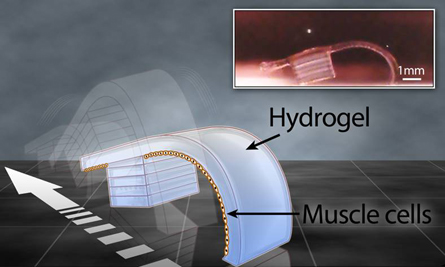- More than 2 years ago
View the video
Fueled by the rhythmic beating of rat heart cells, a soft-bodied robot the size of a grain of rice chugs across a Petri dish. Designed with drafting software on a computer, the bot’s blueprints were brought to life with a 3-D printer at the University of Illinois at Urbana-Champaign.

3-D printers create objects by depositing layer upon layer of a material other than ink, ultimately building a 3-D object from the bottom up. To create the bot, the printer squirts out a layer of liquid hydrogel — a gelatinous mix of water and inert, meshlike molecules — and then stiffens up each layer of the bot’s body with a laser. The bot’s curved “leg” was then seeded with a mix of rat fibroblast and heart cells, which spontaneously contract. After about three days, the cell layer became a synchronized beating sheet whose contractions propelled the springboardlike bot forward.
The beauty of printing the bots, says study leader Rashid Bashir, is it allows for tweaking designs and ingredients until, for example, the bots’ legs are just sticky enough to skip forward. Similar bots may one day serve as traveling sensors that detect chemicals in the environment. “By using cells to build biological machines we may solve problems,” Bashir says. Bashir and colleagues describe the feat online November 15 in Scientific Reports.
A tiny bot chugs forward, powered by the beating of rat heart cells along its curved “leg.”
Credit: V. Chan et al/Scientific Reports 2012





